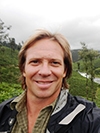
Mentors
Chemistry
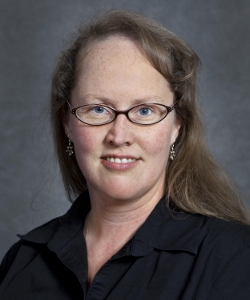
Jenny A. Cappuccio
HSU Department:
Chemistry
Expertise:
Biochemistry, Membrane and Surface Proteins, Nanobiology
I am interested in how membrane and surface proteins interface on the nano-scale. The overarching theme of my research is the interactions of these interface proteins, with their environments. My focus is on understanding the interactions with light, DNA, lipids and metals. Project 1 investigates DNA binding and the effect of lipid composition on a novel photo-active membrane protein, Anabaena Sensory Rhodopsin (ASR), proposed to directly regulate transcription. Project 2 investigates the charge and metal binding affinity of native and modified microbial surface-layer proteins (S-layers) for use in the bioremediation of heavy metals. Other projects that are biochemistry related and are student developed are welcome. A current student directed project involves investigating the pesticide residue on traditional basket weaving materials.
Environmental Sciences

Alison O’Dowd
HSU Department:
Environmental Science
Expertise:
River Ecology and Fish Habitat Assessments
Many rivers in the American West have dams and diversions that can severely alter river ecosystem processes and the biological communities therein. My research explores how dam releases can be managed to provide adequate environmental flows for fish and other aquatic species. Students working with me will examine benthic macroinvertebrate samples collected from the Trinity River downstream from Lewiston Dam in order to assess if pulse release flows enhance food availability for salmonids. This project is in conjunction with the Yurok Tribe, the Hoopa Valley Tribe and the U.S. Department of Fish and Wildlife. There will be opportunities to work with these tribes and other agencies if the REU intern is interested.
Fisheries
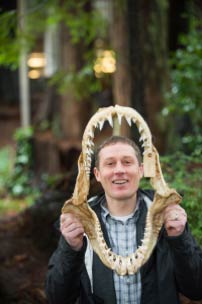
Andrew P. Kinziger
HSU Department:
Fisheries Biology
Expertise:
Conservation Genetics
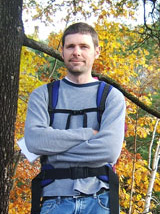
Darren Ward
HSU Department:
Fisheries
Expertise:
Restoration ecology of salmon and trout
Sea-run salmon and trout populations are a critical resource for the tribes of the California coast. Yet, populations of salmon and trout all along the California coast have declined in abundance to the extent that coho salmon, Chinook salmon, and steelhead trout populations are listed on state and federal Endangered Species Acts. Declines in these populations are generally associated with habitat loss from human land use (logging, damming, mining, agriculture, urbanization) or water use. Conservation efforts often entail habitat enhancement or restoration in the freshwater nursery habitats of juvenile salmon and trout. My students and I work on evaluating the success of these habitat restoration efforts in order to determine what types of projects provide the most benefit to salmon and trout populations. Ongoing projects in my lab focus on coho salmon populations in small coastal streams close to Arcata as well as the Klamath/Trinity watershed.
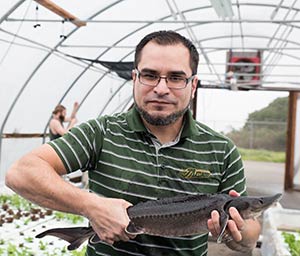
Rafael Cuevas Uribe
HSU Department:
Fisheries Biology
Expertise:
Aquaculture
We import more than 90% of the seafood that we consume. We need to find sustainable ways to produce fish and plants. Aquaponics offers a new way to produce fish and plants in a symbiotic relationship where fish provide most of the plants nutrients and the plants remove the nitrogenous waste thereby cleaning the water for the fish. Aquaponics is one of the fastest growing methods of aquaculture, and it is becoming extremely popular in California. We have several ongoing undergraduate research projects at the Humboldt aquaponics facility. At the moment we are comparing the production of eight basil varieties in our system. The results from this study will be presented by one undergraduate student at the Aquaculture America 2018 Conference. This past summer, one Rroulou'sik student did a research on evaluating the growth and feed utilization of a fish-free diet in white sturgeon. The results from this research were presented at the AISES National Conference and at the INRSEP/CNRS Undergraduate Scientific Research Symposium. Other studies included comparing the growth of different plants such as chard, cilantro, lettuce, and pak choi, the waste utilization from the effluent of the filters, and comparing different filtration systems.
Forestry

Frank Lake
HSU Department:
U.S. National Forest Service
Expertise:
Integration of tribal traditional ecological knowledge into landscape restoration efforts on Karuk Ancestral Territory
The Klamath-Siskiyou bioregion is one of the most geologically and floristically diverse regions on North America, and it provides significant resources for tribal cultures and culturally valued wildlife. Wildland fire is one of the most influential ecological processes that shaped and contributes to the region’s biodiversity, as well as being a major ecosystem driver that many of the tribes rely upon for traditional and contemporary livelihoods. The Western Klamath Restoration Partnership (WKRP) is a landscape restoration effort to promote heterogeneity and resilience of valued natural and cultural resources used by communities in the mid-Klamath River area. If this effort is to succeed, more research is needed on integrating biodiversity and socio-cultural values in the active management of ecosystems and various habitats found in this bioregion. As the local USDA-Forest Service science lead for the WKRP and a Cal Poly Humboldt Department of Forestry adjunct faculty, I strive to work with other university departments/programs, federal agencies, and tribes. Tribal students working with me will be mentored and instructed on methods for integrating tribal traditional ecological knowledge with forestry and wildland fire management, fire effects on natural and cultural resources, and tribally valued wildlife species dependent upon fire. The goal is to increase tribal student knowledge with applied experiences learning from academic and tribal knowledge systems to develop and create the best available science to inform their families, communities and resource managers. Ongoing research relevant to this REU project includes how fire and fuels treatments affect the habitat condition and quality of tribally valued food, basketry, and animal resources. Many wildlife, important to local tribes, also benefit from restoration treatments that increase wild (traditional) food resources.
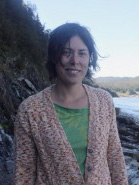
Erin Kelly
HSU Department:
Forestry
Expertise:
Forest Use in Northern California
Potential student projects include 1) documenting tribal forest management knowledge (including Traditional Ecological Knowledge) regarding prescribed fire and fire management; and 2) analyzing tribal land acquisitions in northern California. First, fire prevention and suppression have remained the de facto policy response to fire across the West (and in northern California), despite evidence that the loss of fire as an ecosystem process has contributed to deteriorated forest conditions and fire regimes that threaten natural resources and human communities. Pushback from Tribes has been substantial, for example the Karuk Tribe’s opposition to the US Forest Service-proposed Westside Fire Recovery Project, because of the project’s focus on fire suppression. Student researchers could document tribal views on fire management, both historical and current, and tribal knowledge of fire impacts on cultural resources. Second, the Yurok Tribe has acquired tens of thousands of acres of land from a former industrial landowner, and has created innovative management plans – including management focusing on carbon sequestration.

Rosemary Sherriff
HSU Department:
Geography
Expertise:
Forest Change and Management
A century of fire exclusion across many forests has resulted in profound changes (i.e., fuel, density and composition changes), along with expected shifts in potential wildfire behavior. These changes are particularly acute in forests that historically experienced high-frequency, low-severity fires. In response, federal and state agencies promote large-scale forest management programs to reduce forest density and the potential for severe fire behavior. Treated stands are expected to be more resistant (showing measurably less response) to future wildfire. Less well understood is how well thinning treatment or prescribed fire confers resistance to other forest stressors, such as drought and other disturbances (e.g., beetle outbreaks). Secondly, very little is known about how treatments or recent wildfire activity affect plant biodiversity and culturally-significant species of concern for local tribal communities. Interested students will evaluate if forest treatments in the Klamath region remove enough small trees so that remaining trees have sufficient moisture to survive the on-going drought (through tree growth analysis), and secondly how treatments and recent wildfires affect plant biodiversity and important traditional-use plants. The answer to these questions have profound implications as forest management treatments and wildfires are expected to increase at the same time as pronounced drought stress.
Wildlife

Daniel Barton
HSU Department:
Wildlife
Expertise:
Quantitative Population Ecology
A fundamental goal of both basic ecologists and conservation biologists is to understand population growth. Sometimes lost in pursuit of this goal is the essential point that population ecology is quantitative natural history. Yet, wildlife biology and ecology are increasingly quantitative fields, and undergraduate education in quantitative literacy lags behind. I work with undergraduate and graduate students to improve our individual and collective understanding of applied population ecology and trophic interactions in the context of traditional field natural history. Ongoing research relevant to the proposed REU include a study of the role that native consumers play in mediating the process and impacts of succession and plant invasion on other community members in a coastal dune community and a montane serpentine community, and techniques for estimating songbird and small mammal demographic parameters through capture-recapture. Emerging projects include studies of how experimental removals of introduced recreational sport fisheries imposed on sub-alpine lakes influence transient and steady-state community dynamics through a combination of direct (consumption) and indirect (apparent competition) effects on native amphibians and snakes.
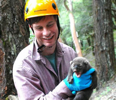
J. Mark Higley
HSU Department:
Expertise:
Hoopa Tribal Forestry, Wildlife Resources on Hoopa Reservation
I have spent my entire career working on the Hoopa Valley Indian Reservation as a wildlife biologist in the tribe’s Forestry Department. Although my main duties have been to complete threatened and endangered species surveys and Consultations with the U.S. Fish and Wildlife Service, I have also had an interest in a variety of research projects mostly addressing management issues. Ongoing research relevant to this REU project includes northern spotted owl (Strix occidentalis caurina) demographic monitoring (initiated in 1992), barred owl (Strix varia) occupancy surveys, fisher (Pekania pennanti pacifica) habitat selection and demographic monitoring (initiated in 2005) and habitat selection of Pileated Woodpeckers (Hylatomus pileatus). We have also conducted research on black bear (Ursus americanus) cambium feeding behavior and its impacts to future timber volume production and more recently, its potential ecological services. Pileated woodpeckers, fisher and black bear all have cultural significance to the Hupa people and several other Klamath basin tribes.

Matt Johnson
HSU Department:
Wildlife
Expertise:
Habitat Ecology of Wildlife in Managed Ecosystems
Approximately 90% of the Earth’s terrestrial land surface is modified and managed for human activity, yet most conservation ecology continues to focus on prioritizing, designing, and protecting the 10% in nature reserves. For conservation to succeed, more research is needed on integrating biodiversity and human activity in managed ecosystems. Students working with me test hypotheses on the relationships between wildlife and their habitats in agricultural lands and managed forests. Ongoing research relevant to this REU project includes investigating the habitat selection of Pileated Woodpeckers (Hylatomus pileatus), a culturally significant species to the Hoopa Valley Tribe. Recently initiated work will examine the role of black bears (Ursus americanus) as ecosystem modifiers in Hoopa, where they damage and kill Douglas-fir trees (Pseudotsuga menziesii), which imparts an economic cost but may also diversify otherwise uniform second growth forests and foster increased wildlife diversity.
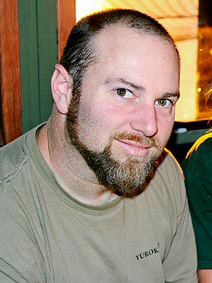
Chris West
HSU Department:
Natural Resources
Expertise:
Wildlife Resources on Yurok Reservation
The Yurok Tribe gained a small portion of their ancestral lands as reservation in 1864. However, much of this land was declared surplus and made available for settlement by non-Indians. Forests were logged and wildlife and fish were depleted. The Tribe re-organized under a new constitution in 1993 and a concerted effort is now being made to reclaim our tribal land base and restore our tribal fishery, water rights, wildlife, and forests. We have many projects that are required to restore wildlife populations ranging from assessing current status to reintroducing regionally extinct species. Current work includes: land assessments related to establishment of California condor (Gymnogyps californianus) release sites, scat collection for genetics based mark-recapture population assessments, monitoring of marbled murrelet (Brachyramphus marmoratus) nesting in relation to proposed timber harvest activities, monitoring of northern spotted owl (Strix occidentalis caurina) nesting in relation to proposed timber harvest activities, and monitoring wood duck (Aix sponsa) nest boxes along creek restoration sites.

Seafha Ramos
HSU Department:
Wildlife, Rroulou’sik REU Coordinator
Expertise:
Philosophy of Indigenous and Western Science Paradigms, Traditional Ecological Knowledge, Wildlife Conservation and Management, Genetic Analysis of Wildlife Scat, Human Dimensions of Wildlife

